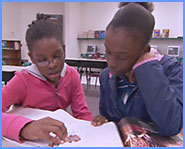Practice: Book Discussion Groups and Literature Circles
-
Sample Lessons:
Relatives (Grades K-2)
After reading a story aloud, students engage in a discussion about what was read, what it means, and connections they can make between the literature, their own lives, and the world around them.A Midsummer Night's Dream (Grades 6-8)
After reviewing key themes and new vocabulary, students read a short story, a book, or a play together.What is Manga? (Grades 8-12)
Japanese Manga and American graphic novels provide teen readers with opportunities for cross-cultural learning, development of discussion skills, and practice with essential comprehension strategies.
Practice: Read Aloud
-
Sample Lessons:
Storytime (Grades K-2)
Explore elements of a read aloud through this lesson by reading a story that engages students, check for understanding, invite predictions, and discuss the key elements of the story.Summertime (Grades K-2)
In this read aloud activity, explore how to engage students in a story, model fluent reading, discuss the themes of the story, and ask students to illustrate their ideas in drawings and dioramas.Newcomers (Grades 2-3)
Using follow-up activities to a read aloud prompts students to extend what they know, apply it in writing or drawing, and make connections to their lives and the world.Who Am I Without Him? (Grades 6-8 (girls))
Students select a text they want to read and explore more deeply through on-going group discussions, writing and other activities.The Eighty Yard Run (Grades 9-12)
This dynamic story by Irwin Shaw provides excellent material for an adolescent read-aloud, addressing key components of high school culture - football and first love.
Practice: Story and Literature Dramatizations
-
Sample Lessons:
The True Story of the 3 Little Pigs (Grades K-2)
After reading and discussing a children's book, students break up into small groups, choose roles, and act out parts.Freeze Frames (Grades 3-8)
Students work collaboratively in small groups to depict a scene or an event from a story in this quick, spontaneous activity.Shakespeare Club (Grades 5-9)
Students memorize a part in A Midsummer Night's Dream, create costumes and a set, and build literacy skills in a fun, engaging way.Creating Student Advertising (Grades 9-12)
Teens analyze how ads work as they develop, create and enact media advertising that expresses their own voices and values.
Practice: Writing
-
Sample Lessons:
My First Book (Grades K-2)
After reading a story and reviewing the elements of a book, students develop ideas and create their own books with a cover, storyline, and illustrations.Recycling (Grades 3-5)
Students read or listen to a story or poem, discuss how it relates to themselves and their world, and create a new piece of writing of their own.Writing and Sharing Community Stories (Grades 9-12)
Students interview community members for personal stories on a shared theme; they write, publish or perform, distribute, and even sell this collection at community events.
Practice: Family Literacy Events
-
Sample Lessons:
Connecting Families through Folk Stories and Fairy Tales (Grades K-5)
Parents are asked to write down a folk story or fairy tale from their childhood in their primary language, and students rewrite the story in English, adding illustrations.Parent University (Grades K-12)
Parent University is a monthly event, designed to get parents and caregivers invested in the school community, while providing tips and tools for families.Creating Star Quality Job Seekers (Grades 9-12)
This project supports young adults with identifying their strengths, presenting them in interviews, and developing good resumés as they seek their first jobs.
Practice: One-on-One and Small Group Tutoring
-
Sample Lessons:
One-on-One Tutoring (Grades K-2)
Students receive one-on-one tutoring that targets areas of reading and writing where students need support, or enrichment activities to enhance students' strengths.Small Group Tutoring (Grades K-2)
Students receive tutoring that targets areas of reading and writing where students need support, or enrichment activities to enhance students' strengths.Analyzing Textbook Formats (Grades 9-12)
Students learn how to: recognize different structures and formats for nonfiction; use common features to find information; read graphs, charts, and illustrations; and navigate through several texts to locate information on one focused topic.





